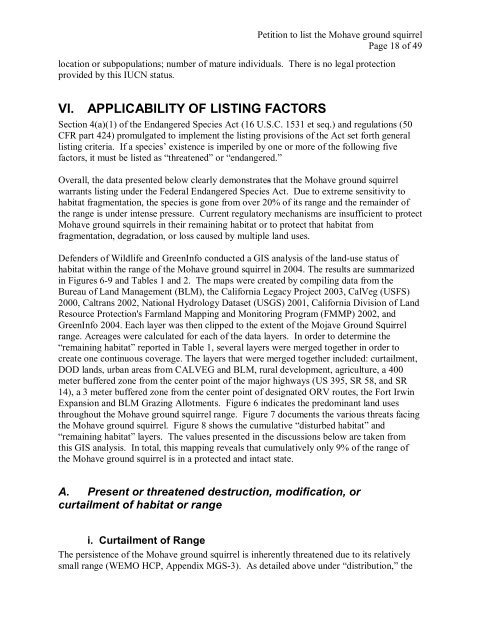Petition to list the Mohave Ground Squirrel - Defenders of Wildlife
Petition to list the Mohave Ground Squirrel - Defenders of Wildlife
Petition to list the Mohave Ground Squirrel - Defenders of Wildlife
You also want an ePaper? Increase the reach of your titles
YUMPU automatically turns print PDFs into web optimized ePapers that Google loves.
<strong>Petition</strong> <strong>to</strong> <strong>list</strong> <strong>the</strong> <strong>Mohave</strong> ground squirrel<br />
Page 18 <strong>of</strong> 49<br />
location or subpopulations; number <strong>of</strong> mature individuals. There is no legal protection<br />
provided by this IUCN status.<br />
VI. APPLICABILITY OF LISTING FACTORS<br />
Section 4(a)(1) <strong>of</strong> <strong>the</strong> Endangered Species Act (16 U.S.C. 1531 et seq.) and regulations (50<br />
CFR part 424) promulgated <strong>to</strong> implement <strong>the</strong> <strong>list</strong>ing provisions <strong>of</strong> <strong>the</strong> Act set forth general<br />
<strong>list</strong>ing criteria. If a species’ existence is imperiled by one or more <strong>of</strong> <strong>the</strong> following five<br />
fac<strong>to</strong>rs, it must be <strong>list</strong>ed as “threatened” or “endangered.”<br />
Overall, <strong>the</strong> data presented below clearly demonstrates that <strong>the</strong> <strong>Mohave</strong> ground squirrel<br />
warrants <strong>list</strong>ing under <strong>the</strong> Federal Endangered Species Act. Due <strong>to</strong> extreme sensitivity <strong>to</strong><br />
habitat fragmentation, <strong>the</strong> species is gone from over 20% <strong>of</strong> its range and <strong>the</strong> remainder <strong>of</strong><br />
<strong>the</strong> range is under intense pressure. Current regula<strong>to</strong>ry mechanisms are insufficient <strong>to</strong> protect<br />
<strong>Mohave</strong> ground squirrels in <strong>the</strong>ir remaining habitat or <strong>to</strong> protect that habitat from<br />
fragmentation, degradation, or loss caused by multiple land uses.<br />
<strong>Defenders</strong> <strong>of</strong> <strong>Wildlife</strong> and GreenInfo conducted a GIS analysis <strong>of</strong> <strong>the</strong> land-use status <strong>of</strong><br />
habitat within <strong>the</strong> range <strong>of</strong> <strong>the</strong> <strong>Mohave</strong> ground squirrel in 2004. The results are summarized<br />
in Figures 6-9 and Tables 1 and 2. The maps were created by compiling data from <strong>the</strong><br />
Bureau <strong>of</strong> Land Management (BLM), <strong>the</strong> California Legacy Project 2003, CalVeg (USFS)<br />
2000, Caltrans 2002, National Hydrology Dataset (USGS) 2001, California Division <strong>of</strong> Land<br />
Resource Protection's Farmland Mapping and Moni<strong>to</strong>ring Program (FMMP) 2002, and<br />
GreenInfo 2004. Each layer was <strong>the</strong>n clipped <strong>to</strong> <strong>the</strong> extent <strong>of</strong> <strong>the</strong> Mojave <strong>Ground</strong> <strong>Squirrel</strong><br />
range. Acreages were calculated for each <strong>of</strong> <strong>the</strong> data layers. In order <strong>to</strong> determine <strong>the</strong><br />
“remaining habitat” reported in Table 1, several layers were merged <strong>to</strong>ge<strong>the</strong>r in order <strong>to</strong><br />
create one continuous coverage. The layers that were merged <strong>to</strong>ge<strong>the</strong>r included: curtailment,<br />
DOD lands, urban areas from CALVEG and BLM, rural development, agriculture, a 400<br />
meter buffered zone from <strong>the</strong> center point <strong>of</strong> <strong>the</strong> major highways (US 395, SR 58, and SR<br />
14), a 3 meter buffered zone from <strong>the</strong> center point <strong>of</strong> designated ORV routes, <strong>the</strong> Fort Irwin<br />
Expansion and BLM Grazing Allotments. Figure 6 indicates <strong>the</strong> predominant land uses<br />
throughout <strong>the</strong> <strong>Mohave</strong> ground squirrel range. Figure 7 documents <strong>the</strong> various threats facing<br />
<strong>the</strong> <strong>Mohave</strong> ground squirrel. Figure 8 shows <strong>the</strong> cumulative “disturbed habitat” and<br />
“remaining habitat” layers. The values presented in <strong>the</strong> discussions below are taken from<br />
this GIS analysis. In <strong>to</strong>tal, this mapping reveals that cumulatively only 9% <strong>of</strong> <strong>the</strong> range <strong>of</strong><br />
<strong>the</strong> <strong>Mohave</strong> ground squirrel is in a protected and intact state.<br />
A. Present or threatened destruction, modification, or<br />
curtailment <strong>of</strong> habitat or range<br />
i. Curtailment <strong>of</strong> Range<br />
The persistence <strong>of</strong> <strong>the</strong> <strong>Mohave</strong> ground squirrel is inherently threatened due <strong>to</strong> its relatively<br />
small range (WEMO HCP, Appendix MGS-3). As detailed above under “distribution,” <strong>the</strong>
















